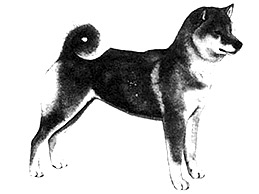Shiba Inu Breed Standard
Last updated: 22 Feb 2017
A breed standard is the guideline which describes the ideal characteristics, temperament, and appearance of a breed and ensures that the breed is fit for function with soundness essential. Breeders and judges should at all times be mindful of features which could be detrimental in any way to the health, welfare or soundness of this breed.

Japan Kennel Club
FCI Standard No 257
Adopted in Australia 1 January 1994
Revised 14 April 1995 - Revision adopted in Australia October 1995
Country of Origin: Japan
-
Group:
Group 6 (Utility)
-
History:
The Shiba has been a native breed to Japan since the primitive ages. The word « Shiba » originally refers to something « small », a « small dog ». The Shiba’s habitat was in the mountainous area facing the Sea of Japan and was used as a hunting dog for small animals and birds. There were slight differences in the breeds according to the areas where they were raised. As dogs like English Setters and English Pointers were imported from England during the period of 1868-1912,
hunting became a sport in Japan and crossbreeding of the Shiba with those English dogs became prevalent and a pure Shiba became rare so that by 1912-1926 pure Shibas confined to these areas became exceedingly scarce. Hunters and other educated persons became concerned with the preservation of the pure Shibas from around 1928 and the preservation of the limited number of pure strains began seriously, and the breed standard was finally unified in 1934. In
1937 the Shiba was designated as a « natural monument » after which the breed was bred and improved to become the breed known today.
-
General Appearance:
Small-sized dog, well balanced, well boned with well developed muscles. Constitution strong. Action quick, free and beautiful.
Important Proportions: The ratio of height at withers to length of body is 10 : 11.
-
Characteristics:
Utilisation: Hunting dog for birds and small animals. Companion dog.
FCI Classification: Group 5 Spitz and primitive type. Section 5 Asian Spitz and related breeds. Without working trial.
-
Temperament:
The temperament is faithful, with keenness in sense and high alertness.
-
Head And Skull:
Cranial Region:
Skull: Forehead broad.
Stop: Well defined with slight furrow.
Facial Region:
Nose: Black. Nasal bridge straight.
Muzzle: Moderately thick.
Lips: Tight.
Cheeks: Well developed.
-
Eyes:
Triangular, not too small, and dark brown in colour. The outer corners of the eyes are slightly upturned.
-
Ears:
Relatively small, triangular, slightly inclining forward and firmly pricked.
-
Mouth:
Teeth strong with scissor bite.
-
Neck:
Thick, strong, and well balanced with the head and the body.
-
Forequarters:
General appearance: Seen from the front, forelegs straight.
Shoulder: Shoulder blade moderately sloping.
Upper arm: Forming a moderate angle with shoulder blade.
Elbow: Tight.
Metacarpus (Pastern): Slightly oblique.
-
Body:
Back straight and strong; loin broad and muscular. Chest deep, ribs moderately sprung, belly well drawn up.
-
Hindquarters:
Upper thigh: Well developed.
Lower thigh: Well developed.
Hocks: Thick and tough.
-
Feet:
Feet: Digits tightly closed and well arched. Pads thick and elastic.
Nails hard and dark in colour desirable.
-
Tail:
Set on high, thick, carried vigorously curled or curved as a sickle, the tip nearly reaching hocks when let down.
-
Gait/Movement:
-
Coat:
Hair: Outer coat harsh and straight, undercoat soft and dense; hair on tail slightly long and standing off.
-
Colour:
Red, black and tan, sesame, black sesame, red sesame.
Definition of the colour sesame:
· Sesame: Good mixture of black, red and white hairs in whole.
· Black sesame: More black than white hairs.
· Red sesame: Ground colour of hair red, mixture with black hairs.
All the above mentioned colours must have « Urajiro ».
« Urajiro » : Whitish coat on the sides of the muzzle and on the cheeks, on the underside of the jaw and neck, on the chest and stomach and the underside of the tail, and on the inside of the legs.
-
Sizes:
Height at withers: Males 39.5 cm. Females 36.5 cm.
There is a tolerance of 1,5 cm smaller or taller.
-
Faults:
Any departure from the foregoing points should be considered a fault and the seriousness with which the fault should be
regarded should be in exact proportion to its degree and its effect upon the health and welfare of the dog.
· Lack of sexual dimorphism.
· Slightly overshot or undershot mouth.
· Numerous teeth missing.
· Shyness.
· Pinto colour.
DISQUALIFYING FAULTS:
· Aggresive or overly shy.
· Any dog clearly showing physical or behavioural abnormalities shall be disqualified.
· Extremely overshot or undershot mouth.
· Ears not pricked.
· Hanging tail, short tail.
-
Notes:
· Male animals should have two apparently normal testicles fully descended into the scrotum.
· Only functionally and clinically healthy dogs, with breed typical conformation, should be used for breeding.
 For owners
For owners
 Members
Members
 Dogs Australia is a not-for-profit organisation advocating for the preservation of purebred dogs through ethical breeding.
It champions the highest standard of animal welfare through education and fostering dog-loving communities.
Internationally recognised and established in 1958 as the Australian National Kennel Council (ANKC),
the organisation promotes responsible dog ownership; maintains the ORCHID* heritable canine diseases database;
funds research into canine diseases; and supports state and territory-based member bodies.
Dogs Australia promotes breed conformation shows and community sports for dogs that fulfil a breed’s natural instincts.
Dogs Australia is a not-for-profit organisation advocating for the preservation of purebred dogs through ethical breeding.
It champions the highest standard of animal welfare through education and fostering dog-loving communities.
Internationally recognised and established in 1958 as the Australian National Kennel Council (ANKC),
the organisation promotes responsible dog ownership; maintains the ORCHID* heritable canine diseases database;
funds research into canine diseases; and supports state and territory-based member bodies.
Dogs Australia promotes breed conformation shows and community sports for dogs that fulfil a breed’s natural instincts.







